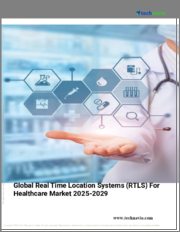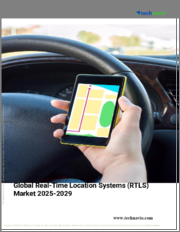
|
시장보고서
상품코드
1596151
세계의 의료용 실시간 위치 정보 시스템 시장 : 부문별 예측(2025-2030년)Real-time Locating Systems for Healthcare Market by Technology (BLE, Infrared, RFID), Component (Hardware, Services, Software), End User - Global Forecast 2025-2030 |
||||||
의료용 실시간 위치 정보 시스템(RTLS, Real-time Locating Systems for Healthcare) 시장은 2023년에 6억 181만 달러로 평가되었고, 2024년에는 7억 909만 달러에 이를 것으로 추정되며, CAGR 17.91%로 성장하며 2030년에는 19억 7,940,000달러에 달할 것으로 예측됩니다.
의료용 실시간 위치 정보 시스템(RTLS)은 운영 효율성, 환자 안전 및 자원 활용을 향상시키는 혁신적인 솔루션으로 꾸준히 주목받고 있습니다. 이러한 시스템은 RFID, Bluetooth, Wi-Fi와 같은 기술을 결합하여 의료 시설 내에서 사람이나 자산의 실시간 위치를 추적합니다. 의료 분야에서 RTLS의 필요성은 환자 결과를 개선하고 프로세스를 간소화하려는 업계의 노력에 의해 강조됩니다. RTLS의 적용은 자산 추적, 환자 흐름 관리, 직원 조정 및 감염 관리 전반에 걸쳐 이루어지며, 주로 병원, 클리닉 및 노인 요양 시설에서 최종적으로 사용됩니다. 의료용 RTLS 시장은 의료 운영의 복잡성 증가, 규정 준수의 필요성, 환자 중심 치료에 대한 강조 증가와 같은 요인에 의해 주도되고 있습니다. 또한 IoT 및 데이터 분석의 발전은 향상된 시스템 복잡성과 예측 분석을 위한 새로운 기회를 제공하고 있습니다. 그러나 높은 구현 비용, 데이터 프라이버시에 대한 우려, 상호 운용성 문제와 같은 문제는 성장을 저해할 수 있습니다. 기회를 활용하기 위해 시장 참여자들은 강력한 데이터 보안 조치를 보장하면서 기존 IT 인프라와 원활하게 통합되는 확장 가능하고 비용 효율적인 RTLS 솔루션을 개발하는 데 집중해야 합니다. 배터리 효율성, 장치 소형화, 전자 건강 기록(EHR)을 통한 향상된 통합 기능 분야에서도 혁신을 추구할 수 있습니다. 또한 AI 기반 분석에 대한 연구는 RTLS 시스템의 기능을 더욱 개선하여 비즈니스 성장을 촉진할 수 있습니다. 이 시장의 특성은 경쟁이 치열하며, 주요 업체들은 입지를 확장하기 위해 전략적 파트너십과 합병에 참여합니다. 그러나 빠른 기술 발전 속도를 고려할 때, 앞서 나가기 위해서는 민첩성과 R&D에 대한 지속적인 투자가 필요할 것입니다. 전반적으로 의료용 RTLS 시장은 이해관계자가 기존 과제를 효과적으로 해결하고 혁신을 새로운 의료 트렌드에 부합한다면 상당한 성장 잠재력을 제공할 수 있습니다.
| 주요 시장 통계 | |
|---|---|
| 기준연도(2023년) | 6억 181만 달러 |
| 추정연도(2024년) | 7억 909만 달러 |
| 예측연도(2030년) | 19억 794만 달러 |
| CAGR(%) | 17.91% |
시장 역학 : 급속히 진화하는 의료용 실시간 위치 정보 시스템 시장의 주요 인사이트 공개
의료용 실시간 위치 정보 시스템 시장은 수요 및 공급의 역동적인 상호작용에 의해 변모를 이루고 있습니다. 이러한 변화하는 시장 역학을 이해하면 비즈니스 조직은 정보에 입각한 투자 결정을 내리고, 전략적 의사 결정을 개선하며, 새로운 기회를 포착할 수 있습니다. 이러한 트렌드를 종합적으로 파악함으로써 비즈니스 조직은 정치적, 지리적, 기술적, 사회적, 경제적 영역에서 다양한 위험을 완화하는 동시에 소비자 행동과 그것이 제조 비용 및 구매 트렌드에 미치는 영향을 더 명확하게 이해할 수 있습니다.
- 시장 성장 촉진요인
- 혁신적이고 맞춤화된 RTLS 솔루션을 제공하는 신흥 기업의 출현
- 의료시설에서 안전성 및 보안에 대한 우려
- 리소스 이용과 워크플로우 최적화의 필요성
- 높은 투자수익률
- 시장 성장 억제요인
- 데이터 보안 및 개인정보 보호에 대한 우려
- 최종 사용자의 불만과 고액의 구입·보수 비용
- 시장 기회
- 하이브리드 RTLS 솔루션 개발
- 헬스케어에서 IoT 기술의 이용
- 시장 과제
- 고정밀도, 고범위, 저전력 요구 사항을 충족하는 RTLS 설계
- 통일규격과 상호운용성 부족
Porter's Five Forces : 의료용 실시간 위치 정보 시스템 시장을 탐색하는 전략 도구
Porter's Five Forces 프레임워크는 시장 상황경쟁 구도를 이해하는 중요한 도구입니다. 이 프레임워크는 비즈니스 조직이 경쟁적 위치를 평가하고 전략적 기회를 탐색할 수 있는 명확한 방법론을 제공합니다. 이 프레임워크는 기업이 시장 내 힘의 역학 관계를 평가하고 새로운 벤처의 수익성을 판단하는 데 도움이 됩니다. 이러한 인사이트를 통해 비즈니스 조직은 강점을 활용하고 약점을 해결하며 잠재적인 문제를 방지하여 보다 탄력적인 시장 포지셔닝을 확보할 수 있습니다.
PESTLE 분석 : 의료용 실시간 위치 정보 시스템 시장의 외부 영향을 파악
외부 거시 환경 요인은 의료용 실시간 위치 정보 시스템 시장의 성과 역학을 형성하는 데 매우 중요한 역할을 합니다. 정치, 경제, 사회, 기술, 법 및 환경 요인 이러한 영향을 탐색하는 데 필요합니다. 정보를 제공합니다. PESTLE 요인을 조사함으로써 기업은 잠재적인 위험과 기회를 더 잘 이해할 수 있습니다. 예측하고 앞으로 예측한 적극적인 의사 결정을 할 준비를 할 수 있습니다.
시장 점유율 분석 : 의료용 실시간 위치 정보 시스템 시장 경쟁 구도 파악
의료용 실시간 위치 정보 시스템 시장의 상세한 시장 점유율 분석을 통해 벤더의 실적을 종합적으로 평가할 수 있습니다. 경쟁 긍정 이를 통해 시장의 집중, 단편화, 통합 동향을 밝혀내고, 벤더는 경쟁이 격화하는 가운데 자신의 지위를 높이는 전략적 의사결정을 하기 위해 필요한 지식을 얻을 수 있습니다.
FPNV 포지셔닝 매트릭스 : 의료용 실시간 위치 정보 시스템 시장에서 공급업체의 성과 평가
FPNV 포지셔닝 매트릭스는 의료용 실시간 위치 정보 시스템 시장에서 벤더를 평가하기 위한 중요한 도구입니다. 충분한 정보를 기반으로 의사 결정을 내릴 수 있습니다.
전략 분석 및 추천 : 의료용 실시간 포지셔닝 시스템 시장에서 성공을 위한 길을 그리기
의료용 실시간 위치 정보 시스템 시장의 전략분석은 글로벌 시장 입지 강화를 목표로 하는 기업에 필수적입니다. 이 접근 방식을 통해 경쟁 구도에서 과제를 극복하고 새로운 비즈니스 기회를 활용하여 장기적인 성공을 거둘 수 있는 시스템을 구축할 수 있습니다.
이 보고서는 주요 관심 분야를 포괄하는 시장의 종합적인 분석을 제공합니다.
1. 시장 침투 : 현재 시장 환경의 상세한 검토, 주요 기업의 광범위한 데이터, 시장 도달범위 및 전반적인 영향력을 평가합니다.
2. 시장 개척도 : 신흥 시장의 성장 기회를 파악하고 기존 분야의 확장 가능성을 평가하며 미래 성장을 위한 전략적 로드맵을 제공합니다.
3. 시장 다양화 : 최근 제품 출시, 미개척 지역, 업계의 주요 진보, 시장을 형성하는 전략적 투자를 분석합니다.
4. 경쟁 평가 및 정보 : 경쟁 구도를 철저히 분석하여 시장 점유율, 사업 전략, 제품 포트폴리오, 인증, 규제 당국 승인, 특허 동향, 주요 기업의 기술 진보 등을 검증합니다.
5. 제품 개발 및 혁신 : 향후 시장 성장을 가속할 것으로 예상되는 최첨단 기술, R&D 활동, 제품 혁신을 강조합니다.
또한 이해관계자가 충분한 정보를 얻고 의사결정을 할 수 있도록 중요한 질문에 대답하고 있습니다.
1. 현재 시장 규모와 향후 성장 예측은?
2. 최고의 투자 기회를 제공하는 제품, 부문 및 지역은?
3. 시장을 형성하는 주요 기술 동향 및 규제 영향은?
4. 주요 벤더의 시장 점유율과 경쟁 포지션은?
5. 벤더 시장 진입·철수 전략의 원동력이 되는 수익원 및 전략적 기회는?
목차
제1장 서문
제2장 연구 방법
제3장 주요 요약
제4장 시장 개요
제5장 시장 인사이트
- 시장 역학
- 성장 촉진요인
- 혁신적이고 맞춤화된 RTLS 솔루션을 제공하는 스타트업 출현
- 의료시설에서 안전과 시큐리티의 우려
- 리소스 활용과 워크플로 최적화 필요성
- 높은 투자수익률
- 억제요인
- 데이터 보안 및 개인정보 보호에 대한 우려
- 최종 사용자의 불만과 취득 및 유지에 드는 비용 규모
- 기회
- 하이브리드 RTLS 솔루션 개발
- 헬스케어에서 IoT 기술의 활용
- 과제
- 고정밀, 고범위, 저전력 요구 사항을 충족하는 RTLS 설계
- 통일된 표준과 상호 운용성 부족
- 성장 촉진요인
- 시장 세분화 분석
- Porter's Five Forces 분석
- PESTEL 분석
- 정치적
- 경제적
- 사회적
- 기술적
- 법적
- 환경적
제6장 의료용 실시간 위치 정보 시스템 시장 : 기술별
- BLE
- 적외선
- RFID
- 초음파
- 초광대역
- Wi-Fi
제7장 의료용 실시간 위치 정보 시스템 시장 : 컴포넌트별
- 하드웨어
- 리더/트래커/액세스 포인트
- 센서/태그/배지
- 서비스
- 컨설팅
- 전개 및 통합
- 지원 및 유지 보수
- 소프트웨어
- 애플리케이션
- 위치 분석 엔진
- 미들웨어
제8장 의료용 실시간 위치 정보 시스템 시장 : 최종 사용자별
- 학술연구기관
- 외래센터
- 병원과 간호 서비스 제공업체
- 연구소
제9장 아메리카의 의료용 실시간 위치 정보 시스템 시장
- 아르헨티나
- 브라질
- 캐나다
- 멕시코
- 미국
제10장 아시아 태평양의 의료용 실시간 위치 정보 시스템 시장
- 호주
- 중국
- 인도
- 인도네시아
- 일본
- 말레이시아
- 필리핀
- 싱가포르
- 한국
- 대만
- 태국
- 베트남
제11장 유럽·중동 및 아프리카의 의료용 실시간 위치 정보 시스템 시장
- 덴마크
- 이집트
- 핀란드
- 프랑스
- 독일
- 이스라엘
- 이탈리아
- 네덜란드
- 나이지리아
- 노르웨이
- 폴란드
- 카타르
- 러시아
- 사우디아라비아
- 남아프리카공화국
- 스페인
- 스웨덴
- 스위스
- 터키
- 아랍에미리트(UAE)
- 영국
제12장 경쟁 구도
- 시장 점유율 분석(2023년)
- FPNV 포지셔닝 매트릭스(2023년)
- 경쟁 시나리오 분석
- 전략 분석 및 추천
기업 목록
- Airista Flow, Inc.
- CenTrak, Inc.
- DecaWave Limited
- HPE Aruba
- Identec Group AG
- Impinj, Inc.
- Intelligent InSites, Inc.
- Mojix Inc.
- Redpine Signals, Inc.
- Sanitag
- Sonitor Technologies, Inc.
- STANLEY Healthcare
- TeleTracking Technologies, Inc.
- Versus Technology, Inc.
- Zebra Technologies Corporation
The Real-time Locating Systems for Healthcare Market was valued at USD 601.81 million in 2023, expected to reach USD 709.09 million in 2024, and is projected to grow at a CAGR of 17.91%, to USD 1,907.94 million by 2030.
Real-time Locating Systems (RTLS) in healthcare have steadily gained traction as a transformative solution to enhance operational efficiency, patient safety, and resource utilization. These systems leverage a combination of technologies such as RFID, Bluetooth, and Wi-Fi for tracking the real-time location of people or assets within healthcare facilities. The necessity of RTLS in healthcare is underscored by the industry's drive to improve patient outcomes and streamline processes. Applications of RTLS span across asset tracking, patient flow management, staff coordination, and infection control, with end-use mostly in hospitals, clinics, and elderly care facilities. The market for RTLS in healthcare is driven by factors such as the increasing complexity of healthcare operations, the need for compliance with regulations, and the growing emphasis on patient-centric care. Additionally, advancements in IoT and data analytics are providing fresh opportunities for enhanced system intrication and predictive analytics. However, challenges such as high implementation costs, concerns over data privacy, and interoperability issues can hinder growth. To capitalize on opportunities, market players should focus on developing scalable and cost-effective RTLS solutions that integrate seamlessly with existing IT infrastructure while ensuring robust data security measures. Innovation can also be pursued in the areas of battery efficiency, miniaturization of devices, and enhanced integration capabilities with electronic health records (EHR). Moreover, research into AI-driven analytics could further refine the functionality of RTLS systems, thereby driving business growth. The nature of this market is highly competitive, with key players engaging in strategic partnerships and mergers to expand their footprint. However, given the rapid pace of technological advancement, staying ahead will require agility and continual investment in R&D. Overall, the RTLS market in healthcare offers substantial growth potential, provided stakeholders effectively address the existing challenges and align innovations with emerging healthcare trends.
| KEY MARKET STATISTICS | |
|---|---|
| Base Year [2023] | USD 601.81 million |
| Estimated Year [2024] | USD 709.09 million |
| Forecast Year [2030] | USD 1,907.94 million |
| CAGR (%) | 17.91% |
Market Dynamics: Unveiling Key Market Insights in the Rapidly Evolving Real-time Locating Systems for Healthcare Market
The Real-time Locating Systems for Healthcare Market is undergoing transformative changes driven by a dynamic interplay of supply and demand factors. Understanding these evolving market dynamics prepares business organizations to make informed investment decisions, refine strategic decisions, and seize new opportunities. By gaining a comprehensive view of these trends, business organizations can mitigate various risks across political, geographic, technical, social, and economic domains while also gaining a clearer understanding of consumer behavior and its impact on manufacturing costs and purchasing trends.
- Market Drivers
- Emergence of startups providing innovative and customized RTLS solutions
- Safety and security concerns in healthcare facilities
- Need for resource utilization and workflow optimization
- High return on investment
- Market Restraints
- Concerns regarding data security and privacy
- Dissatisfaction among end users and high cost of acquisitions and maintenance
- Market Opportunities
- Development of hybrid RTLS Solutions
- Use of IoT technology in healthcare
- Market Challenges
- Designing RTLS satisfying high accuracy, high range, and low power consumption requirements
- Lack of uniform standards and interoperability
Porter's Five Forces: A Strategic Tool for Navigating the Real-time Locating Systems for Healthcare Market
Porter's five forces framework is a critical tool for understanding the competitive landscape of the Real-time Locating Systems for Healthcare Market. It offers business organizations with a clear methodology for evaluating their competitive positioning and exploring strategic opportunities. This framework helps businesses assess the power dynamics within the market and determine the profitability of new ventures. With these insights, business organizations can leverage their strengths, address weaknesses, and avoid potential challenges, ensuring a more resilient market positioning.
PESTLE Analysis: Navigating External Influences in the Real-time Locating Systems for Healthcare Market
External macro-environmental factors play a pivotal role in shaping the performance dynamics of the Real-time Locating Systems for Healthcare Market. Political, Economic, Social, Technological, Legal, and Environmental factors analysis provides the necessary information to navigate these influences. By examining PESTLE factors, businesses can better understand potential risks and opportunities. This analysis enables business organizations to anticipate changes in regulations, consumer preferences, and economic trends, ensuring they are prepared to make proactive, forward-thinking decisions.
Market Share Analysis: Understanding the Competitive Landscape in the Real-time Locating Systems for Healthcare Market
A detailed market share analysis in the Real-time Locating Systems for Healthcare Market provides a comprehensive assessment of vendors' performance. Companies can identify their competitive positioning by comparing key metrics, including revenue, customer base, and growth rates. This analysis highlights market concentration, fragmentation, and trends in consolidation, offering vendors the insights required to make strategic decisions that enhance their position in an increasingly competitive landscape.
FPNV Positioning Matrix: Evaluating Vendors' Performance in the Real-time Locating Systems for Healthcare Market
The Forefront, Pathfinder, Niche, Vital (FPNV) Positioning Matrix is a critical tool for evaluating vendors within the Real-time Locating Systems for Healthcare Market. This matrix enables business organizations to make well-informed decisions that align with their goals by assessing vendors based on their business strategy and product satisfaction. The four quadrants provide a clear and precise segmentation of vendors, helping users identify the right partners and solutions that best fit their strategic objectives.
Strategy Analysis & Recommendation: Charting a Path to Success in the Real-time Locating Systems for Healthcare Market
A strategic analysis of the Real-time Locating Systems for Healthcare Market is essential for businesses looking to strengthen their global market presence. By reviewing key resources, capabilities, and performance indicators, business organizations can identify growth opportunities and work toward improvement. This approach helps businesses navigate challenges in the competitive landscape and ensures they are well-positioned to capitalize on newer opportunities and drive long-term success.
Key Company Profiles
The report delves into recent significant developments in the Real-time Locating Systems for Healthcare Market, highlighting leading vendors and their innovative profiles. These include Airista Flow, Inc., CenTrak, Inc., DecaWave Limited, HPE Aruba, Identec Group AG, Impinj, Inc., Intelligent InSites, Inc., Mojix Inc., Redpine Signals, Inc., Sanitag, Sonitor Technologies, Inc., STANLEY Healthcare, TeleTracking Technologies, Inc., Versus Technology, Inc., and Zebra Technologies Corporation.
Market Segmentation & Coverage
This research report categorizes the Real-time Locating Systems for Healthcare Market to forecast the revenues and analyze trends in each of the following sub-markets:
- Based on Technology, market is studied across BLE, Infrared, RFID, Ultrasound, UWB, and Wi-Fi.
- Based on Component, market is studied across Hardware, Services, and Software. The Hardware is further studied across Readers/Trackers/Access Points and Sensors/Tags/Badges. The Services is further studied across Consulting, Deployment & Integration, and Support & Maintenance. The Software is further studied across Application, Location Analytics Engine, and Middleware.
- Based on End User, market is studied across Academic & Research Institutes, Ambulatory Centers, Hospitals & Care Providers, and Laboratories.
- Based on Region, market is studied across Americas, Asia-Pacific, and Europe, Middle East & Africa. The Americas is further studied across Argentina, Brazil, Canada, Mexico, and United States. The United States is further studied across California, Florida, Illinois, New York, Ohio, Pennsylvania, and Texas. The Asia-Pacific is further studied across Australia, China, India, Indonesia, Japan, Malaysia, Philippines, Singapore, South Korea, Taiwan, Thailand, and Vietnam. The Europe, Middle East & Africa is further studied across Denmark, Egypt, Finland, France, Germany, Israel, Italy, Netherlands, Nigeria, Norway, Poland, Qatar, Russia, Saudi Arabia, South Africa, Spain, Sweden, Switzerland, Turkey, United Arab Emirates, and United Kingdom.
The report offers a comprehensive analysis of the market, covering key focus areas:
1. Market Penetration: A detailed review of the current market environment, including extensive data from top industry players, evaluating their market reach and overall influence.
2. Market Development: Identifies growth opportunities in emerging markets and assesses expansion potential in established sectors, providing a strategic roadmap for future growth.
3. Market Diversification: Analyzes recent product launches, untapped geographic regions, major industry advancements, and strategic investments reshaping the market.
4. Competitive Assessment & Intelligence: Provides a thorough analysis of the competitive landscape, examining market share, business strategies, product portfolios, certifications, regulatory approvals, patent trends, and technological advancements of key players.
5. Product Development & Innovation: Highlights cutting-edge technologies, R&D activities, and product innovations expected to drive future market growth.
The report also answers critical questions to aid stakeholders in making informed decisions:
1. What is the current market size, and what is the forecasted growth?
2. Which products, segments, and regions offer the best investment opportunities?
3. What are the key technology trends and regulatory influences shaping the market?
4. How do leading vendors rank in terms of market share and competitive positioning?
5. What revenue sources and strategic opportunities drive vendors' market entry or exit strategies?
Table of Contents
1. Preface
- 1.1. Objectives of the Study
- 1.2. Market Segmentation & Coverage
- 1.3. Years Considered for the Study
- 1.4. Currency & Pricing
- 1.5. Language
- 1.6. Stakeholders
2. Research Methodology
- 2.1. Define: Research Objective
- 2.2. Determine: Research Design
- 2.3. Prepare: Research Instrument
- 2.4. Collect: Data Source
- 2.5. Analyze: Data Interpretation
- 2.6. Formulate: Data Verification
- 2.7. Publish: Research Report
- 2.8. Repeat: Report Update
3. Executive Summary
4. Market Overview
5. Market Insights
- 5.1. Market Dynamics
- 5.1.1. Drivers
- 5.1.1.1. Emergence of startups providing innovative and customized RTLS solutions
- 5.1.1.2. Safety and security concerns in healthcare facilities
- 5.1.1.3. Need for resource utilization and workflow optimization
- 5.1.1.4. High return on investment
- 5.1.2. Restraints
- 5.1.2.1. Concerns regarding data security and privacy
- 5.1.2.2. Dissatisfaction among end users and high cost of acquisitions and maintenance
- 5.1.3. Opportunities
- 5.1.3.1. Development of hybrid RTLS Solutions
- 5.1.3.2. Use of IoT technology in healthcare
- 5.1.4. Challenges
- 5.1.4.1. Designing RTLS satisfying high accuracy, high range, and low power consumption requirements
- 5.1.4.2. Lack of uniform standards and interoperability
- 5.1.1. Drivers
- 5.2. Market Segmentation Analysis
- 5.3. Porter's Five Forces Analysis
- 5.3.1. Threat of New Entrants
- 5.3.2. Threat of Substitutes
- 5.3.3. Bargaining Power of Customers
- 5.3.4. Bargaining Power of Suppliers
- 5.3.5. Industry Rivalry
- 5.4. PESTLE Analysis
- 5.4.1. Political
- 5.4.2. Economic
- 5.4.3. Social
- 5.4.4. Technological
- 5.4.5. Legal
- 5.4.6. Environmental
6. Real-time Locating Systems for Healthcare Market, by Technology
- 6.1. Introduction
- 6.2. BLE
- 6.3. Infrared
- 6.4. RFID
- 6.5. Ultrasound
- 6.6. UWB
- 6.7. Wi-Fi
7. Real-time Locating Systems for Healthcare Market, by Component
- 7.1. Introduction
- 7.2. Hardware
- 7.2.1. Readers/Trackers/Access Points
- 7.2.2. Sensors/Tags/Badges
- 7.3. Services
- 7.3.1. Consulting
- 7.3.2. Deployment & Integration
- 7.3.3. Support & Maintenance
- 7.4. Software
- 7.4.1. Application
- 7.4.2. Location Analytics Engine
- 7.4.3. Middleware
8. Real-time Locating Systems for Healthcare Market, by End User
- 8.1. Introduction
- 8.2. Academic & Research Institutes
- 8.3. Ambulatory Centers
- 8.4. Hospitals & Care Providers
- 8.5. Laboratories
9. Americas Real-time Locating Systems for Healthcare Market
- 9.1. Introduction
- 9.2. Argentina
- 9.3. Brazil
- 9.4. Canada
- 9.5. Mexico
- 9.6. United States
10. Asia-Pacific Real-time Locating Systems for Healthcare Market
- 10.1. Introduction
- 10.2. Australia
- 10.3. China
- 10.4. India
- 10.5. Indonesia
- 10.6. Japan
- 10.7. Malaysia
- 10.8. Philippines
- 10.9. Singapore
- 10.10. South Korea
- 10.11. Taiwan
- 10.12. Thailand
- 10.13. Vietnam
11. Europe, Middle East & Africa Real-time Locating Systems for Healthcare Market
- 11.1. Introduction
- 11.2. Denmark
- 11.3. Egypt
- 11.4. Finland
- 11.5. France
- 11.6. Germany
- 11.7. Israel
- 11.8. Italy
- 11.9. Netherlands
- 11.10. Nigeria
- 11.11. Norway
- 11.12. Poland
- 11.13. Qatar
- 11.14. Russia
- 11.15. Saudi Arabia
- 11.16. South Africa
- 11.17. Spain
- 11.18. Sweden
- 11.19. Switzerland
- 11.20. Turkey
- 11.21. United Arab Emirates
- 11.22. United Kingdom
12. Competitive Landscape
- 12.1. Market Share Analysis, 2023
- 12.2. FPNV Positioning Matrix, 2023
- 12.3. Competitive Scenario Analysis
- 12.4. Strategy Analysis & Recommendation
Companies Mentioned
- 1. Airista Flow, Inc.
- 2. CenTrak, Inc.
- 3. DecaWave Limited
- 4. HPE Aruba
- 5. Identec Group AG
- 6. Impinj, Inc.
- 7. Intelligent InSites, Inc.
- 8. Mojix Inc.
- 9. Redpine Signals, Inc.
- 10. Sanitag
- 11. Sonitor Technologies, Inc.
- 12. STANLEY Healthcare
- 13. TeleTracking Technologies, Inc.
- 14. Versus Technology, Inc.
- 15. Zebra Technologies Corporation



















